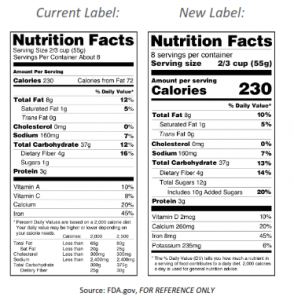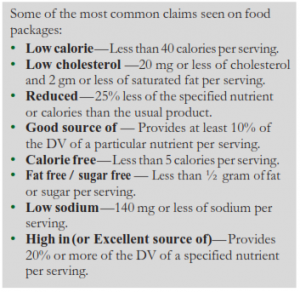Become a smart shopper by reading food labels to find out more about the foods you eat. The Nutrition Facts panel found on most food labels will be changing in the near future, and the updates will help you:
- Find out which foods are good sources of dietary fiber, vitamin D, calcium, iron, and potassium
- Compare similar foods to find out which one is lower in calories
- Look for foods that are lower in saturated fat, trans fat, sodium, and added sugars
Start with the Servings Per Container and Serving Size
- Look here for both the number of servings in the package and the serving size (the amount for one serving)

- Remember to check your portion size to the serving size listed on the label. If the label serving size is one cup, and you eat two cups, you are getting twice the calories, fat and other nutrients listed on the label
Check Out the Total Calories
- Find out how many calories are in a single serving
Let the Percent Daily Values Be Your Guide
Use percent Daily Values (DV) to help you evaluate how a particular food fits into your daily eating plan:
- Daily Values are average levels of nutrients for a person eating 2,000 a day
- Remember: percent DV are for the entire day— not just for one meal or snack
- You may need more or less than 2,000 calories per day. For some nutrients you may need more or less than 100% DV
- 5 percent or less is low — try to aim low in saturated fat, trans fat, cholesterol, and sodium
- 20 percent or more is high — try to aim high in vitamins, minerals and dietary fiber
Limit Saturated Fat, Trans Fat, Sodium, and Added Sugars
Eating less of these may help reduce your risk of heart disease, high blood pressure and cancer:
- Limit saturated fats to less than 10% of total calories daily by replacing them with unsaturated fats
- Limit trans fat to as low as possible
- Limit sodium to less than 2,300 mg daily (for adults and children 14 years and older)
- Limit added sugar to less than 10% of total calories daily
Get Enough Vitamins, Minerals and Fiber
- Eat more dietary fiber, vitamin D, calcium, and potassium to maintain good health and help reduce your risk of certain health problems such as osteoporosis
- Remember to aim high for % DV of these nutrients
Additional Nutrients
- Carbohydrates — There are three types of carbohydrates: sugars, starches and fiber. Select whole-grain breads, cereals, rice and pasta plus fruits, vegetables, and low-fat milk and yogurt
- Proteins — Aim for a variety, including seafood, poultry, lean meats, eggs, beans and peas, nuts, seeds, and soy products

Check the Ingredient List
Foods with more than one ingredient must have an ingredient list on the label. Ingredients are listed in descending order by weight. Those in the largest amounts are listed first. Food manufacturers are required to state if food products contain any ingredients that are derived from the eight major allergenic foods: milk, eggs, fish, crustacean shellfish, tree nuts, peanuts, wheat and soybeans.
What Health Claims on Food Labels Really Mean
FDA has strict guidelines on how certain food label terms can be used. FDA also sets standards for health-related claims on food labels to help consumers identify foods that are rich in nutrients and may help to reduce the risk for certain diseases. For example, health claims may highlight the link between calcium and osteoporosis, dietary fiber and some cancers, saturated fat and heart disease or high blood pressure and sodium.
Source: www.eatright.org




